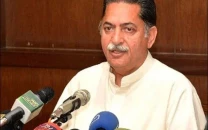With drying up of streams, Kohistan’s water woes resurface
Residents eyeing private investors, and not the government, to meet their power needs.

Tired by the government’s empty promises, people in Kohistan have been generating electricity on their own for the past many years. But now, with most of their hydropower generators lying idle, residents are looking towards private investors, and not the government, to meet their power needs.
With the Water and Power Development Authority (WAPDA) being able to power a mere portion of only one of the four tehsils of the district in the past six decades, the residents realised, though much later, that electricity was a necessity that they had to provide for themselves, said Fazal Rehman, a resident of Dassu tehsil.
After a bit of brainstorming, the villagers decided to install small and medium-sized hydropower generators on streams and brooks that are fed water from springs, said Rehman. The self-sufficiency plan worked well for many years and the dozens of generators kept providing cheap electricity.
Each of the 3 to 30 kilowatt power generators, the latter costing an estimated Rs200,000 to 250,000, powered over 30 houses in their vicinity, usually belonging to a particular tribe, said Rehman. Consumers would pay Rs100 per week as operational charge for the facility and could operate a tube light, a fan and an iron, he said.
Apart from the few hours that the generators were switched off for maintenance, there was no loadshedding and no hefty electricity charges on consumers, added Yakoot Khan, a private power producer.
But those were the good times.
Due to rising temperature and changing climatic conditions, the springs barely have enough water flowing and streams are running dry. Around 90% of the over 120 hydropower generators in Dassu are now lying idle and its ever-increasing population is again without electricity, said Habat Khan, another power producer. He said that electricity is a necessity and it is the government’s duty to provide people such basic facilities.
Shamasur Rehman Shams, a local journalist, said that Kohistan has the potential to generate its own electricity but its resources have not been harnessed. “It is due to the government’s lack of attention that Kohistan is underdeveloped and has high levels of poverty and illiteracy,” he said.
To a question on the role of private investors, Shams said that non-governmental organisations (NGOs)have been working on various uplift projects in the district, but local clergymen have turned against them and demand that they be ousted from the area.
He said that despite the clergymen’s reservations, locals have requested the NGOs to urge private investors to set up power plants across the district. He said that since WAPDA was unable implement an electrification plan from Pattan to Dassu by June, despite being provided Rs150 million by the government, the authority has earned a bad reputation across the district and people are willing to throw their weight behind private power producers instead.
Kohistan is a remote area of Hazara division and was given the status of district during the government of Zulfikar Ali Bhutto. It is abundant in natural resources including wood, water and minerals.
*Edited by Bilal Raza
Published in The Express Tribune, July 21st, 2012.



















COMMENTS
Comments are moderated and generally will be posted if they are on-topic and not abusive.
For more information, please see our Comments FAQ